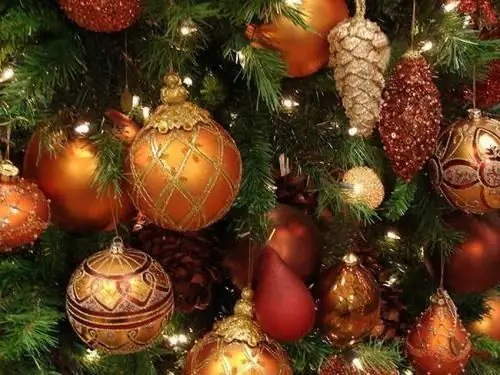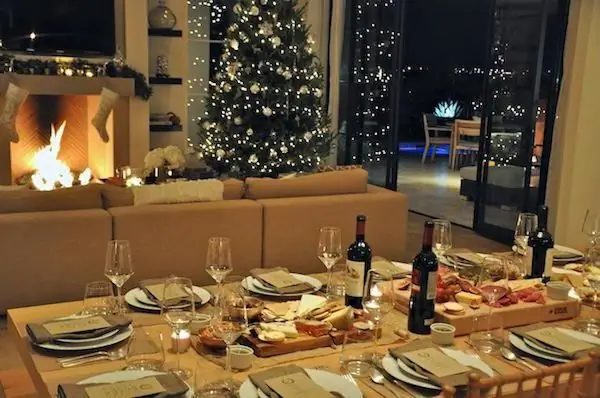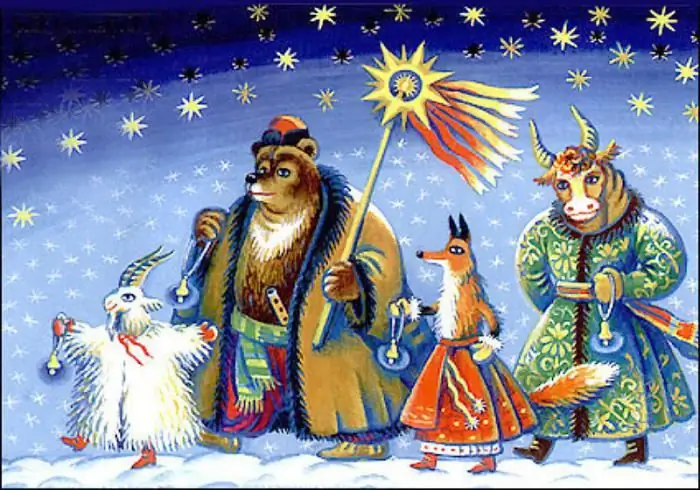2025 Author: Priscilla Miln | [email protected]. Last modified: 2025-01-22 17:55:20
In Poland, Christmas is one of the main holidays of the year, just like Easter. A huge number of traditions are associated with its celebration, which all Poles try to honor. The date of Christmas in Poland coincides with the celebration in other European countries and the USA - December 25th. The New Year is celebrated here on the night of December 31 to January 1 and is called St. Sylvester's Day.
What is Vigilia?
Poles call Vigilia Christmas Eve. On this day, all people try to create a warm and cozy atmosphere around themselves, avoid scandals with all their might. In Poland, they believe: how you spend Christmas Eve is how you will live the whole next year.
According to tradition, the whole family sits down at the table on Christmas Eve. It is better if before that everyone defended the service in the temple. Vigil dinner completes Advent, so the dishes on the table are still lenten. By tradition, a snow-white tablecloth should lie on the table, and straw under it.

This is a tribute to the stable and manger where Jesus was born. Generally, ChristmasPoland and traditions are inseparable concepts.
Free seat at the Christmas table and payment
Poles always leave one free place at the festive table, served with cutlery. This belief has its roots in the distant past. Previously, it was believed that this is due to the ancient tradition of leaving a place for the soul at the wake. Now free space is more associated with a traveler. And as they say in Poland, it is not known who this traveler will be, and whether it will be Jesus himself.
Oplatek is unleavened bread, symbolizing the body of Christ in the Christian faith. The breaking of this bread at Christmas in Poland is one of the most important traditions. The division begins with the head of the family, after which each member breaks off a piece and gives his neighbor a payment to break off from his piece.
Other table traditions for Vigilia
It has long been customary to invite an even number of guests on Christmas Eve. They were especially afraid of the number 13 and avoided it in every possible way. But if the number of guests still turned out to be odd, they invited another one. Poor people called a lonely neighbor, and rich people called a clergyman. Guests were seated at the table either by age or by position in society.
Traditionally, an odd number of dishes were placed on the table on Christmas Eve.

In the old days, peasants put 5 or 7 dishes, we althy people - 9, and the nobility - 11. The presence of 12 dishes on the table was also allowed, since this number is equal to the number of apostles.
Many people go to Europe for Christmas to get acquainted with local traditions and feel the holiday spirit. Buttourists should know in advance how shops in Poland work at Christmas. Most of them will be closed on December 25 and 26, January 1, and January 6 - the Three Kings Day.
What is served on the table for Christmas
Now it is customary to serve 12 dishes on the table - according to the number of apostles. The guest must try every dish, but do not overeat. Soup opens the feast. It can be mushroom, fish, almond or linen. Borscht is also popular. Traditionally, kutya, bigos and fish dishes are not complete.
The highlight of the Christmas program in Poland is carp. His head must be eaten by the owner, this shows respect for him. After the carp is eaten, the owner of the house puts its scales in his wallet. It is believed that this will bring happiness and financial well-being to the house.
Each dish on the table traditionally carries a semantic load. Poppy must be present (for example, poppy seed roll). He will bring peace to the house and a good harvest. This ingredient was also added to kutya. It also contained wheat as a symbol of life and honey as a symbol of the victory of good over evil. At present, even if the hostess does not prepare kutya for Christmas (in Poland), she always puts its components on the table separately.

Now the family gathering at the table on Christmas Eve chatting and laughing cheerfully, discussing all the news. Previously, it was prohibited. The whole dinner passed in silence, and only the hostess could even get up from the table when this or that treat was over.
Of course, not without dessert. In hisas it is customary to serve favernhu - cookies with honey and nuts, as well as chocolate cake.
The first star and the edlka are integral Christmas traditions in Poland
It was possible to invite people to the Polish table, laden with rich dishes, only after the first star had risen in the sky. Catholics have long since clearly followed this rule, and it has not been forgotten even now. This tradition comes from the rising of the Star of Bethlehem, when the Magi found the newborn Savior in the manger.
Edlka is the top part of spruce or pine. In Poland, she always hung under the very ceiling and protected the owners of the house from evil spirits. Now it has been replaced by a full dressed spruce or its branches.

Christmas and New Year's trees in Poland took root not so long ago. Only in the 18th century did the mention of spruce as a Christmas tree appear in the country. At first, the Polish church did not appreciate the idea, but was able to quickly change it in its own way. Apples on spruce began to symbolize the forbidden fruit from the Garden of Eden, the star on top - the Star of Bethlehem. The Christmas tree stands in Polish homes until January 6.
It is impossible not to mention another Christmas tradition that has taken root not only in Poland - giving gifts. Of course, on this bright holiday, it is customary to give gifts to the closest people.
What happened after the feast?
What happened after the gala dinner defied a single description. All parts of the country had their own traditions. There was only one thing in common - all the remnants of the meal should immediately be given to pets. The priority washorned animals. It is believed that representatives of this kind of living creatures were present at the birth of the Savior and received the gift of speech. From this comes the tradition of the Lenten table for Catholic Christmas in Poland.
After the feast, people still love to carol.

The mummers go from house to house most often in Polish villages. They choose the costume of a goat as a symbol of fertility, a stork as a symbol of the New Year, or a bear as a symbol of the forces of nature. Polish folk tradition has managed to preserve a huge number of Christmas songs that are still popular today. Children crow under the tables so that there are chickens, and the owner "scares" the fruit trees in the garden with an ax. Amateur shows are also popular, where stories from the Gospel are played.
In some regions of the country, after the holiday, it was customary to go to the cemetery to honor the memory of deceased relatives.
New Year in Poland
The article has already described in detail how Christmas is celebrated in Poland. The New Year holiday, which is celebrated on the night of December 31 to January 1, will not go unnoticed. Many tourists prefer to visit the country at this time, because all the cities are shrouded in fun and festive mood. Folk festivals, carnivals are very attractive for both tourists and the local population. Guests of the city can celebrate the New Year, or Sylvester's Day (as they say in Poland), in local colorful restaurants that offer an interesting program and national cuisine. A tourist should remember how they work in Poland at Christmas - shopsclosed on public holidays December 25, 26, January 1 and 6.
On New Year's Eve, Poles walk noisily: loud music sounds, singing and laughter are heard everywhere, colorful and impressive fireworks are thundering.
Polish New Year traditions
In the New Year, a series of carnivals traditionally takes place in the country. Shows, dances and pranks literally flood the city streets. Also, the Poles arrange "Kulig" - this is a round dance of the sleigh, without which not a single year can do.

After having fun in the fresh air, the Poles move to the fire. Here everyone is treated to fried sausages. Also on holidays it is customary to bake brushwood, donuts, and on the final carnival day, everyone eats herring.
Poles prefer Gzhanets (similar to mulled wine) among drinks. In the capital, it is sold on every corner, and every tourist is simply obliged to try it. It is poured from wooden barrels, which is especially liked by the guests of Warsaw. The New Year is noisy here.
If you value comfort more, then go to the city of Krakow. Here they often spend time not on street festivities, but peacefully sitting in restaurants.
An excellent idea would be to celebrate the New Year in the ski resort of Zakopane. Here they go skiing and snowboarding, sledding and skating. Not to be missed is the mountain tram ride.
If you're dreaming of a holiday in Europe, Poland is the perfect place to be, as there's so much to see and prices are lower compared to other countries.
Symbols of holidays - Saint Nicholas and Sylvester
For Russian people a symbolNew Year's miracle is everyone's favorite Santa Claus. The Poles also have such a character - this is St. Nicholas. This is a charming and hardworking grandfather, a meeting with which all the children of the country are waiting. December 6th is Saint Nicholas Day. On this holiday, children receive gifts and wait for the arrival of Nicholas at Christmas. They believe that gifts are given only to obedient children, so they try to behave well.

The symbol of the New Year in Poland is St. Sylvester, a Roman bishop who died in 335. At that time, the Catholic world was covered in panic: everyone believed that the end of the world was coming, and the formidable serpent Leviathan would come out of the sea and devour everything. Then the people found a protector - they became Saint Sylvester. According to legend, he managed to defeat Leviathan and saved the world.
As you can see, Christmas traditions in Poland are strong and have been able to pass through the centuries. But the most important thing for Poles is to spend Christmas night with family. Very few people allow themselves to celebrate this holiday outside the home.
Recommended:
Celebration of the New Year: history and traditions. New Year Celebration Ideas

Preparing for the New Year can be done in different ways. Some of us love a quiet family holiday with Russian salad and a Christmas tree decorated with antique toys. Others go to celebrate the New Year in another country. Still others gather a huge company and arrange a noisy celebration. After all, a magical night happens only once a year
Where to celebrate the New Year? New Year tours in Russia and other countries

The first snow has just fallen outside, and everyone is already wondering where to celebrate the New Year. After all, the sooner you start planning a holiday, the more likely it is that it will go exactly as it was intended
New Year at school. New Year's events. How to decorate the school for the New Year

New Year at school is an interesting solemn event, for which you definitely need to prepare for the celebration to be held at the highest level
Christmas Eve - what is it? When does Christmas Eve start? History of Christmas Eve

Today, unfortunately, the great church holiday Christmas Eve has already been forgotten. What it is, now only a few know. And in the time of our great-grandmothers, he was glorified more than Christmas. Let's talk about how we prepared for this day and how our distant ancestors celebrated it
History of the holiday Old New Year. Rituals, signs and traditions for the Old New Year

What dates our history does not contain! The Old New Year holiday is not in any calendar of the world, but for almost a century it has been celebrated in our country and in some states of near and far abroad. Almost two weeks after the first of January, the fun at the Christmas tree is back. The current dual tradition is very surprising to foreigners, and not all of our compatriots know why this is happening. Where did the custom of celebrating the Old New Year come from? What date is it marked?

